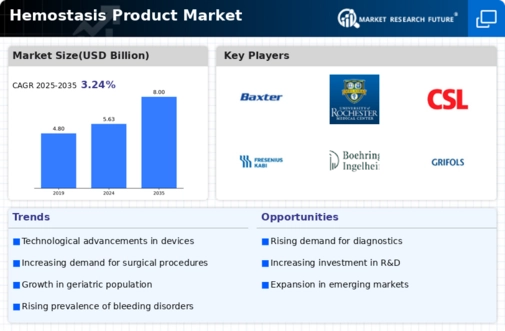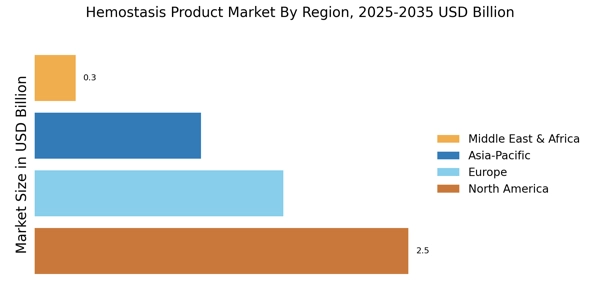Increasing Surgical Procedures
The rising number of surgical procedures worldwide is a pivotal driver for the Hemostasis Product Market. As surgical techniques become more sophisticated, the need for effective hemostatic agents to manage bleeding during operations is paramount. Data suggests that the volume of surgical procedures is expected to increase by approximately 10% annually, driven by an aging population and the prevalence of chronic diseases. This trend necessitates the use of advanced hemostatic products to ensure patient safety and minimize complications. Consequently, manufacturers are focusing on developing products that cater to various surgical specialties, thereby expanding their market reach. The increasing surgical volume is likely to propel the demand for hemostatic products, contributing to the overall growth of the market.
Rising Incidence of Trauma Cases
The Hemostasis Product Market is significantly influenced by the rising incidence of trauma cases globally. Trauma remains a leading cause of morbidity and mortality, necessitating effective hemostatic solutions to manage severe bleeding. Reports indicate that trauma cases are projected to rise by 5% annually, driven by factors such as road accidents and violence. This alarming trend underscores the urgent need for rapid and effective hemostatic interventions in emergency settings. As a result, healthcare providers are increasingly investing in advanced hemostatic products that can be deployed in pre-hospital and hospital environments. The growing focus on trauma care is expected to enhance the demand for hemostatic agents, thereby fostering market expansion.
Growing Awareness of Blood Management
The increasing awareness of blood management practices is emerging as a significant driver for the Hemostasis Product Market. Healthcare professionals are recognizing the importance of effective hemostatic strategies in minimizing blood loss during surgical and trauma procedures. Educational initiatives and guidelines promoting optimal blood management are being implemented across healthcare systems. This heightened awareness is leading to a greater adoption of hemostatic products that enhance patient outcomes and reduce the need for blood transfusions. As hospitals and surgical centers prioritize blood conservation strategies, the demand for innovative hemostatic solutions is expected to rise. This trend is likely to contribute to the overall growth of the hemostasis product market.
Regulatory Support for Hemostasis Products
Regulatory bodies are playing a crucial role in shaping the Hemostasis Product Market by providing support for the development and approval of innovative hemostatic agents. Streamlined regulatory pathways and incentives for research and development are encouraging manufacturers to invest in new product development. For instance, the introduction of expedited review processes for breakthrough hemostatic products is facilitating faster market entry. This regulatory environment is likely to stimulate competition among manufacturers, leading to a wider array of options for healthcare providers. As regulatory support continues to evolve, it is anticipated that the market for hemostatic products will experience accelerated growth, driven by the introduction of novel and effective solutions.
Technological Innovations in Hemostasis Products
The Hemostasis Product Market is experiencing a surge in technological innovations that enhance the efficacy and safety of hemostatic agents. Advanced materials and delivery systems are being developed, which improve the precision of hemostatic interventions. For instance, the integration of nanotechnology in hemostatic products has shown promise in accelerating clot formation and reducing bleeding times. Furthermore, the introduction of point-of-care testing devices allows for rapid assessment of coagulation status, facilitating timely interventions. This technological evolution is expected to drive market growth, as healthcare providers increasingly adopt these advanced solutions to improve patient outcomes. The market for hemostatic products is projected to reach USD 5 billion by 2026, indicating a robust demand for innovative solutions.


















Leave a Comment